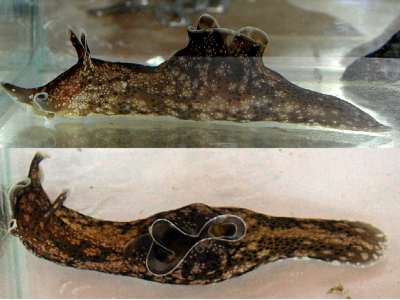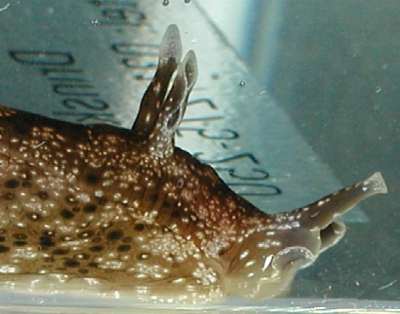Aplysia punctata from Croatia
March 4, 2005
From: Andrej Jaklin


Dear Bill,
I'm sending you three pictures of presumably Aplysia punctata. All the characteristics fit to the descriptions found in literature except one tiny detail. All three specimens collected bear small dark brown spots with white centre, which make them eye like. And that should be the characteristic of another species, A. oculifera from the Red Sea.
Moreover, I found the same spots on some pictures of A. parvula from Erwin's MEDSLUG site! That raises some questions in my head and really would like to see your comment, as well as from others on the Forum.
Locality: Vrsar, Croatia, Northern Adriatic. Depth: 2 m. Length: approx 60 mm. 22 Feb 2005. Caulerpa racemosa settlement. Photographer: Dr. Bojan Hamer [in aquarium]
Best regards,
AJ
jakin@cim.irb.hr
Jaklin, A., 2005 (Mar 4) Aplysia punctata from Croatia. [Message in] Sea Slug Forum. Australian Museum, Sydney. Available from http://www.seaslugforum.net/find/13270Dear Andrej,
Sea Hares can at times be quite difficult to identify from photos. Both European species, A. depilans and A. punctata have the parapodia joined quite high at the back of the animal, as does A. parvula. In A. oculifera the parapodia are not really joined posteriorly. If your animal has a large opening or foramen in the mantle, through which the shell can be seen, then its most likely to be A. punctata or possibly A. parvula. See my earlier comments [message #1435] on the difficulty of separating those two species.
Concerning 'eye spots'. Other species do sometimes have some. For example the photos of Aplysia parvula from Senegal [message #10382] show some good eye spots. This doesn't really answer your question. I think the best way to identify species of Aplysia is to become familiar with your local populations. Once you have an idea of expected colour variablity, it is usually much simpler to identify each population to a species. I realise that it is always possible that an unusual interloper will appear, but if you know the local species reasonably well, the stray one will be fairly obvious.
Best wishes,
Bill Rudman
Related messages
-
Re: Aplysia punctata mating, spawning and variations
From: Joao Pedro Tojal Loia Soares Silva, October 3, 2007 -
Aplysia punctata from the Western Isles, Scotland
From: Lindsay Bradley, October 3, 2007 -
Aplysia punctata mating, spawning and variations
From: Joao Pedro Silva, August 20, 2007 -
Aplysia punctata mating
From: Jim Anderson, August 20, 2007 -
Re: Appetitive behaviour in Aplysia
From: Mark Henry, August 22, 2006 -
Appetitive behaviour in Aplysia
From: Mark Henry, August 21, 2006 -
Markings on Aplysia punctata
From: Mark Henry, August 17, 2006 -
A summer spawn of Aplysia punctata
From: Mark.Henry, August 15, 2006 -
Sea Hare from Lochiver, Northwest Scotland
From: Colin Robertson, March 28, 2006 -
Spanish Sea Hares
From: Sascha Schulz, February 20, 2006 -
Sea Hare from Spain
From: Raul Castro, December 17, 2005 -
Aplysia punctata from Scotland
From: Cherry Welsh, August 19, 2005 -
Juvenile Aplysia from Norway
From: Kåre Telnes, July 30, 2005 -
Aplysia from Croatia
From: Andrej Jaklin, March 4, 2005 -
Age determination of Aplysia punctata
From: Marta K. Soffker, February 18, 2005 -
Aplysia punctata mating
From: Jim Anderson, November 27, 2003 -
Aplysia punctata from French Mediterranean
From: Marina Poddubetskaia, July 19, 2003 -
Aplysia punctata (adult) from French Brittany
From: Marina Poddubetskaia, April 29, 2003 -
Aplysia punctata (juvenile) from French Brittany
From: Marina Poddubetskaia, April 29, 2003 -
Aplysia punctata in aquarium
From: Michael, November 10, 2002 -
Re: commensal bivalve & Aplysia
From: Dr.Stephen R Hoskins, June 18, 2002 -
Re: Commensal bivalve - Sea Hare
From: Dr. Stephen R. Hoskins, June 17, 2002 -
Re: galeommatoidean commensal on Aplysia?
From: Serge Gofas , June 13, 2002 -
Aplysia punctata and commensal? bivalve.
From: Stephen Hoskins, June 8, 2002 -
Aplysia punctata in Germany
From: Peter Gleisenstein , May 31, 2002 -
Aplysia punctata & 'passengers'
From: Dr. Stephen Hoskins, May 16, 2002 -
Aplysia punctata from Portugal
From: João Tojal Silva, April 23, 2002 -
Aplysia punctata defensive mechanism
From: Marilyn Jackson, December 13, 2000 -
What does Aplysia punctata eat?
From: Trevor Shand, August 7, 2000 -
Observations on Aplysia punctata
From: Andy Horton, October 2, 1999
